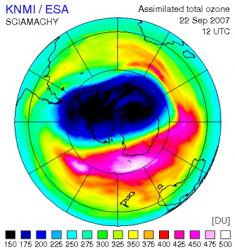Good news everyone; the ozone hole above Antarctica has shrunk 30% since the same last year. According to ESA’s Envisat satellite, the ozone layer only lost a mere 27.7 million tonnes. Down from last year’s record loss of 40 million tonnes. But don’t jump to conclusions; it doesn’t necessarily mean that the ozone layer is recovering… yet.
As you probably know, the ozone layer is a region of the Earth’s atmosphere that contains a high volume of ozone – the combination of three oxygen molecules. This ozone acts like a shield, protecting us from harmful ultraviolet radiation from the Sun. Over the last decade, the ozone layer has thinned by about 0.3% per year across the entire planet, increasing everyone’s chances for skin cancer, cataracts, and causing damage to marine life. We now know that industrial chemicals like refrigerants are largely to blame for destroying this atmospheric ozone, and there has been a worldwide effort to reduce their use.
And then in 1985, a hole opened up above Antarctica, where there was almost no ozone in the atmosphere, and UV radiation from the Sun could stream right in unblocked.
Scientists measure ozone loss by calculating the area of the hole above Antarctica. This year, that size was 24.7 million sq km, roughly the size of North America. But the 30% smaller hole is probably a coincidence due to natural temperature and atmospheric dynamics.
Here’s what scientists think is happening. During last year’s season, the ozone hole wasn’t situated directly over the south pole, instead it was off to one side. This allowed it to mix with warmer air. And the warm air is the key: ozone is depleted when atmospheric temperatures go below -78 degrees Celsius. Since there was warmer air mixed in the area, it slowed down the process of ozone depletion.
Next year, you could just as easily have the opposite situation, with ozone being destroyed at greater rates. Instead, we need to look at the long term trends, and those don’t show that the ozone layer is on the road to recovery yet.
Original Source: ESA News Release

